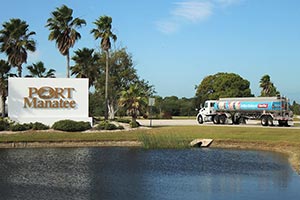Port Manatee Expands Bulk-Fuel Operations

Port Manatee said fuel operations are undergoing significant expansion, with additional capacity and a long-term contract extension expected to further increase liquid bulk cargo volumes at the port while supporting growth of RaceTrac Petroleum Inc.’s fueling station presence in Florida.
Port Manatee’s growing role as “the Port of Southwest Florida gains a further boost with the expansion of operations at our regional fuel hub, with increasing liquid bulk cargo volume translating to higher port revenues as well as more high-paying jobs for our community,” Betsy Benac, chairwoman of the Manatee County Port Authority, said in a statement.
RELATED: After Panama Canal expansion, Port Manatee optimistic for more business
An 80,000-barrel tank is slated to re-enter service in mid-2017, bringing total active capacity of TransMontaigne Partners at Port Manatee to 1.5 million barrels, according to the port, which is located in Palmetto, Florida, near Tampa.
In conjunction with the tank recommissioning, TransMontaigne’s entire light oil contract at Port Manatee is being extended for five years from the date the tank goes back into service, said Fred Boutin, CEO of the Denver-based fuel terminal and transport firm.
“Separately, we entered into an agreement with 200,000 barrels of previously uncontracted storage capacity at our Port Manatee terminal,” said Boutin, who in a Nov. 8 corporate earnings call noted that TransMontaigne is making an investment of about $2.5 million in Florida assets.
“The expanding operational capacity at Port Manatee is important to RaceTrac’s fuel transportation business,” Max McBrayer, chief supply officer for RaceTrac, said in a statement. “These recent improvements will allow us to deliver fuel more efficiently to our always-expanding store presence in Florida and, in particular, the more than 25 RaceTrac stores in the southwest area of the state.”
Port Manatee said it is the closest U.S. deepwater seaport to the expanded Panama Canal and Cuba’s Port of Mariel, with 10 40-foot draft berths serving container, bulk, breakbulk, heavylift, project and general cargo customers.

